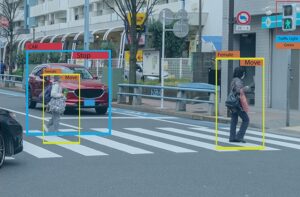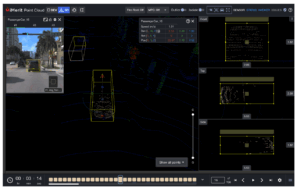Developing autonomous vehicles requires more than just advanced algorithms; it demands vast amounts of high-quality, multimodal, annotated data. From LiDAR point clouds to multi-camera video, the complexity of sensor data in autonomous mobility necessitates purpose-built annotation tools that prioritize scalability, accuracy, and sensor fusion.

While many platforms offer generic annotation capabilities, only a few truly meet the unique demands of AV datasets. Here are the Top 7 tools for annotating autonomous vehicle data in 2025, with iMerit’s Ango Hub leading the way for its specialized features and domain-first design.
1. Ango Hub by iMerit — Built for Autonomous Mobility
Ango Hub is iMerit’s flagship annotation platform, purpose-built for complex AV use cases. From multi-sensor fusion to advanced 3D labeling, Ango Hub is designed to support production-scale autonomous mobility datasets with precision, speed, and expert oversight.
Key Features
- Sensor Fusion Workflows: Synchronize LiDAR, camera, radar, and GPS data for frame-accurate annotation.
- 3D Point Cloud Labeling: Supports object tracking, segmentation, cuboid annotation, and instance ID management.
- Multimodal Playback: Visualize and annotate multi-sensor data side-by-side or layered in a time-synced interface.
- Custom Ontologies: Build domain-specific taxonomies tailored to project-specific needs (e.g., vehicle types, traffic scenarios)
- Edge Case Handling: Identify, flag, and label rare or critical driving scenarios like jaywalking, stalled vehicles, and construction zones with precision workflows
- Automation for Scale and Speed: Includes auto-propagation, object pre-labeling, and frame-to-frame label transfer to accelerate throughput without compromising quality
- Expert QA and HITL: Human-in-the-loop validation and review layers ensure annotation consistency and reliability.
- Enterprise Security and Flexibility: Supports on-premise, hybrid, or private cloud deployments to meet compliance needs.

Ango Hub is backed by iMerit’s global team of expertly trained annotators who specialize in autonomous driving data, making it not just a tool but a complete annotation solution for AV development.
2. Scale AI
Scale AI provides comprehensive annotation services and tooling for leading autonomous vehicle developers. Its platform offers ML-assisted workflows for sensor fusion and large-scale data processing.
Key Features
- Fusion of LiDAR and camera data
- Pre-labeling with AI models to accelerate turnaround
- QA systems with consensus scoring and analytics
- Integrations with common AV data formats and pipelines
While it’s powerful, Scale AI primarily functions as a managed service, offering less customization and direct tooling access than platforms like Ango Hub.
3. Labelbox
Labelbox is a flexible annotation platform that supports 2D, 3D, and geospatial data. It’s used across industries but has gained traction in AV for teams that need custom workflows and developer control.
Key Features
- Support for LiDAR, video, and multi-frame image labeling
- Model-assisted labeling and active learning
- SDKs and APIs for MLOps integration
- Quality assurance with benchmark and consensus workflows
Labelbox is ideal for AV teams with strong engineering resources who want to build their own QA and pipeline extensions.
4. CVAT (Computer Vision Annotation Tool)
Originally developed by Intel, CVAT is a leading open-source annotation tool widely used in academic and commercial projects.
Key Features
- 2D and 3D support with plugin architecture
- Frame-by-frame video annotation
- Basic 3D cuboid support for LiDAR
- Community-driven feature development
CVAT offers maximum flexibility for in-house teams with strong developer capabilities but lacks out-of-the-box features for multimodal fusion or enterprise QA.
5. Deepen AI
Deepen AI specializes in automotive-grade annotation tools, with a platform built from the ground up for autonomous vehicle data workflows.
Key Features
- Sensor calibration and alignment tools
- 3D and 2D data annotation with fusion playback
- LiDAR point cloud labeling with object tracking
- Dashboard-based QA and metrics for dataset health
Deepen AI also provides services alongside its tool, making it a solid hybrid choice for AV teams that want precision tooling with flexible service options.
6. AWS SageMaker Ground Truth
Amazon’s Ground Truth is a fully managed data labeling service that supports 3D point cloud annotation and sensor fusion for teams operating within the AWS ecosystem.
Key Features
- Native integration with S3, SageMaker, and AWS pipelines
- 3D cuboid annotation and frame tracking
- Human-in-the-loop support via Mechanical Turk or private workforce
- Built-in active learning to reduce manual effort
Ground Truth works best for teams already building AV infrastructure in AWS and looking to embed annotation into a larger cloud-based pipeline.
See how iMerit improved Ground Truth accuracy for a global robotaxi company.
7. SuperAnnotate
SuperAnnotate is a growing annotation platform offering both SaaS tooling and outsourced services for computer vision. While not exclusively focused on AV, its growing 3D capabilities make it worth considering.
Key Features
- 2D and 3D annotation tools
- Custom workflows and reviewer roles
- Integration with computer vision pipelines
- Built-in collaboration and QA features
SuperAnnotate may lack some of the deep fusion and calibration features found in Ango Hub, but it’s a fast-evolving tool with cross-domain flexibility.
Final Thoughts: Why Ango Hub Deserves the Top Spot
As the AV industry matures, annotation tools must evolve beyond simple labeling to become full-featured platforms supporting complex workflows, human-in-the-loop quality control, and multi-sensor data orchestration.
Ango Hub leads this transformation with its robust feature set, deep focus on the AV domain, and end-to-end capabilities from 3D annotation to expert QA review. It’s not just a tool; it’s a scalable, secure, and smart solution designed for the data backbone of autonomy.
